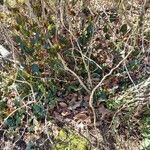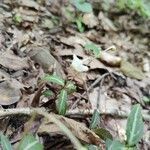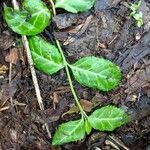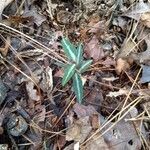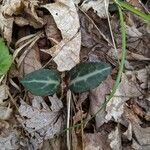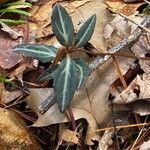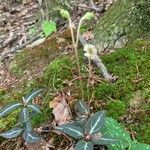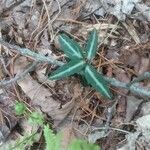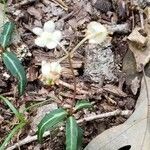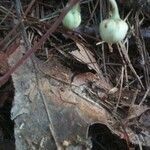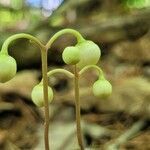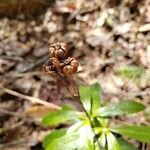Plants rhizomatous, 1-5.3 dm. Leaves: petiole 3-13 mm, terete or channeled adaxially, glabrous; blade maculate, dull and light green abaxially, shiny and green to dark green with white achlorophyllous tissue bordering larger veins adaxially, lanceolate or ovate-lanceolate to oblong-lanceolate or ovate, 20-100 × 8-31 mm, base rounded to obtuse or acute, margins coarsely serrate, apex acute to acuminate. Inflorescences (1-)2-5-flowered; peduncle 1(-2) per stem, 4-19 cm, papillose to hispidulous; inflorescence bracts acicular to linear-lanceolate, free portions shorter than pedicels from which they arise, 4-6 × 0.4-0.6 mm, membranous, margins entire. Pedicels (4-)8-25 mm. Flowers: calyx lobes spreading or reflexed in fruit, entirely greenish or margins whitish green, broadly ovate, 1.4-4.1 × 1.3-4.5 mm, margins erose-denticulate, apex rounded to obtuse; petals white or pink, often tinged violet, orbiculate, 6-12 × 4.5-8 mm, margins fimbriate to erose-denticulate; stamens 6-8 mm; filament base 1.2-1.6 mm wide, dilated basal portion densely villous; anthers 2-4 mm, thecae white to tan or pinkish, tubules tan to pinkish brown, 0.8-1.1 mm, abruptly narrowed from thecae, lateral walls not touching, pores 0.3-0.5 × 0.3-0.5 mm; ovary papillose in lines; style 0.5-1 mm; stigma 2-3.5 mm wide. Capsules depressed-globose, 5-10 × 5-10 mm. 2n = 26.
More
Flowering branches 1–2 dm tall; lvs 2–7 cm, lanceolate, striped with white along the midvein and to a lesser extent along the primary lateral veins, remotely and sharply toothed, acute to rounded at base, short-petioled; fls (1)2–5 and umbellate, 12–18 mm wide, dilated part of the filaments villous. Dry woods, especially in sandy soil; Me. and N.H. to Mich., s. to S.C., Ga. and Ala. June–Aug., after no. 1 [Chimaphila umbellata (L.) Barton].
A herb. It grows 10-25 cm tall. The stems come from creeping rhizomes. The leaves are dark green with lighter patches along the veins and 2-7 cm long by 1-3 cm wide. The flowers are almost round and white or pink. They are on long stalks. The fruit are small capsules 6-8 mm across.
